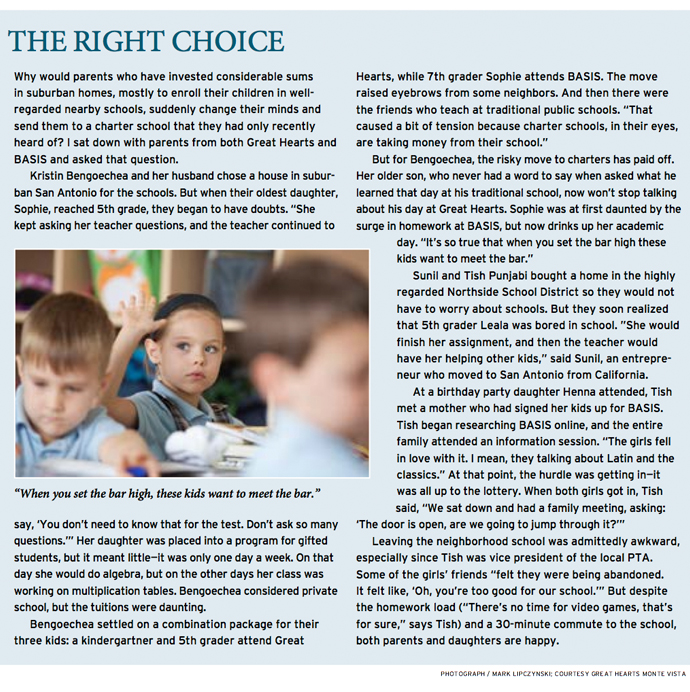There didn’t appear to be anything extraordinary about this December morning gathering of about 40 middle-school parents in the multipurpose room at BASIS San Antonio North charter school. The topic: a “charters 101” presentation about Texas charter-school politics.
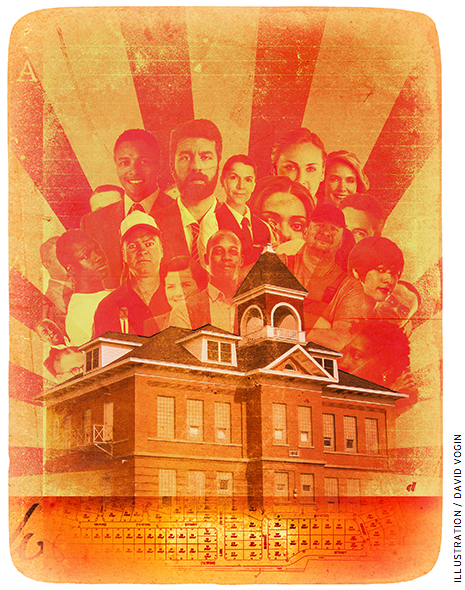 Then came the pitch: Are you willing to write a letter to state officials asking permission for BASIS to open up K–5 schools to feed into their existing middle schools? Sure, many of the parents answered.
Then came the pitch: Are you willing to write a letter to state officials asking permission for BASIS to open up K–5 schools to feed into their existing middle schools? Sure, many of the parents answered.
Parents lobbying on behalf of charter schools is nothing new. Who doesn’t remember the massive march in New York City—thousands of children and parents trudging across the Brooklyn Bridge wearing T-shirts with slogans such as “My Child, My Choice,” all to protest the crackdown on charters by New York’s new mayor?
But there’s more to this story. The two BASIS charter schools in San Antonio, along with a Great Hearts Academies charter, are part of an effort to lure top charter schools into the city, and not just into the low-income neighborhoods where charters are traditionally found. San Antonio and the surrounding Bexar County are served by 17 independent school districts, ranging from high-poverty San Antonio Independent School District to the wealthy districts on the north side of the city. Some parents in the higher-income districts are disenchanted with the local schools, and they are looking for options. These “soccer moms and dads,” who typically opt for more academically rigorous schools, lend political heft to the broader charter movement in that city. In a political battle, who doesn’t want them on their side?
What’s happening here raises a compelling question: could an influx of middle-class parents into charter schools emerge as a political game changer? It’s too early to answer that question, but it’s the right time to ask it.
The San Antonio charter story is only one among many across the country that involve middle-class parents. In Arizona, parents see charters as akin to high-end grocers Whole Foods and Trader Joe’s—options that doctors and lawyers and mayors might choose. In California, especially in rural areas, charters offer parents their only options for specialty schools such as Montessori and Waldorf. For these parents, unlike their counterparts in San Antonio, the attraction is an education philosophy rather than accelerated academics.
Yet another reason middle-class parents are becoming more familiar with charters is the “intentionally diverse” school movement. Charters ranging from the Denver School of Science and Technology network to the E. L. Haynes Public Charter School in Washington, D.C., intentionally draw a mix of families, by race and income.
The rise in middle-class students attending charter schools is largely masked by the overall growth of charter schools: over the last five years, the number of charter schools has grown nationally from 4,690 to just over 6,000. There are now 43 communities where at least 20 percent of the students attend charters, reports the National Alliance for Public Charter Schools. Most of that growth is found in low-income, high-minority neighborhoods such as those in Los Angeles. Between 2005 and 2010, the percentage of suburban charters actually fell from 25 to 21 percent of the total. Thus, what’s happening in San Antonio, Washington, D.C., Denver, and cities across the country remains hidden.
There are some compelling reasons why growth in charters that appeal to middle-class parents is likely to continue. As researchers have documented (see “U.S. Students from Educated Families Lag in International Tests,” features, Fall 2014), even middle-class and suburban parents have reason to find fault with their schools. And while most still trust their local schools, those who don’t are enough to fill schools such as BASIS and Great Hearts.
And there are obvious political advantages for the charters of having these parents onboard. San Antonio parent Kerri Smith sent a two-page letter to every Texas official overseeing charters, explaining, “Had my children not been given the opportunity to attend a BASIS school, I truly fear that they would have continued to go through traditional public school in the middle of the pack, not reaching their full potential and not being fully prepared to go off to college one day.”
Changing the Game in San Antonio

If you had to name the “mastermind” behind the push to bring more charter schools to San Antonio, it would be Victoria Rico, who is something of an accidental school-reform champion. A San Antonio native and lawyer, and the granddaughter and daughter of well-known lawyers there, Rico was asked to take over the George W. Brackenridge Foundation, a little-known foundation with modest assets that mostly funded small education projects, such as field trips and summer camps. Considering the problems in the city school districts, the foundation grants seemed insignificant to her. But what to do? After she visited a local KIPP (Knowledge Is Power Program) school and viewed the movie Waiting for “Superman,” the answer suddenly became clear: pull multiple San Antonio foundations together to attract more high-performing charter schools to the city.
Rico, who one Brackenridge board member dubbed “Hurricane Victoria” for her intense focus and determination, did exactly that. KIPP and IDEA Public Schools were showered with new help. But the interesting part of the plan was her insistence on pulling in charters that appeal to middle-class parents, a strategy rooted in a broader perspective. “To be internationally competitive, we need to close the international achievement gap for all of our students, including our relatively advanced students,” said Rico. “A happy side effect of this is that when you build schools that are rigorous enough to close the international achievement gap, they are attractive to middle-class families as well as low-income families.”
BASIS Schools and Great Hearts Academies were the obvious choices, and they quickly set up San Antonio operations (BASIS in 2013 and Great Hearts in 2014) that they plan to expand. Their schools couldn’t be more different. BASIS, which offers students a chance to pursue world-class academics at their own pace, also grants its students (and teachers) world-class freedoms. Wear what your mood that morning dictates and express yourself loudly in the hallways and cafeteria seem to be the rules. Considering the heavy homework load at these schools, the trade-off seems fair.
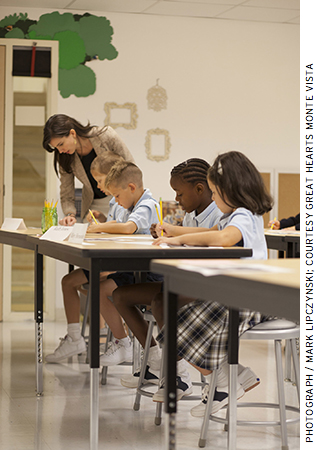
By contrast, Great Hearts students wear uniforms, file quietly through the halls, and study the Great Books. Found on each classroom wall are the Great Hearts nine “core virtues”: humility, integrity, friendship, perseverance, wisdom, courage, responsibility, honesty, and citizenship.
At Great Hearts, prospective teachers are first reviewed for their character. At BASIS, teachers are first reviewed for their content knowledge; PhDs are not uncommon (see “High Scores at BASIS Charter Schools,” features, Winter 2014). But while the schools have radically different feels, what I found interesting was the number of parents with one child in BASIS and another in Great Hearts. To them, what mattered most were the highly rigorous academics. After that, choosing a school was more about the personal style of the child.
As I discovered in my interviewing, there’s an unexpected sweet spot for charters: middle-class parents who are desperate for a curriculum that will challenge their bored sons and daughters but who are unable or unwilling to pay private school tuitions (see “The Right Choice” sidebar below). For those parents, schools such as BASIS may lack lush soccer fields, but the academics equal or surpass those of many private schools, all at the right price: free.
Anyone expecting these schools to be white enclaves will be surprised. At the two BASIS schools, 36 percent of the students are white, 33 percent Hispanic, and 24 percent Asian/Pacific Islander. The schools appear to be especially appealing to South Asian families. At Great Hearts, about half the students are white; few are Asian. This school attracts a great many middle-class Hispanics, including families who want their children to be part of the next-generation San Antonio leadership. The metropolitan area is about 55 percent Hispanic.
Intentionally Diverse Schools
Blackstone Valley Prep Mayoral Academy may have one of the most compelling launch stories of any charter school network in the nation. In 2007, when Dan McKee was mayor of Cumberland, Rhode Island (in 2014 he was elected lieutenant governor of the state), he famously asked, “What kind of public school system would we have if we could just build it from scratch?” McKee’s answer: he wanted schools as diverse as his son’s basketball team. “His son benefited from the diversity, and other kids on the team benefited from being around his son and peers,” said Jeremy Chiappetta, executive director of Blackstone Valley Prep (BVP), the school McKee helped launch (see “The Mayors’ Charter Schools,” features, Winter 2014).
That diversity was achieved by building a regional coalition that includes two suburban communities, Lincoln and Cumberland, and two urban, Central Falls and Pawtucket. A lottery pulls equal numbers from all four, but the lottery is also weighted toward low-income students.
Blackstone is an ideal school for answering a key question: do charters that serve a socioeconomic mix of students look and feel different from charters that target only low-income students? In short, yes. Leslie Royal, a BVP parent who works as dean of operations at a Blackstone elementary school, previously worked at an urban “no excuses” charter school. That strict culture was appropriate for the students there, she said, but not necessarily for her son. “Many middle-class parents who are relatively successful in their fields know how to prep their kids to start kindergarten and what experiences they need to expose them to for their kids to be well-rounded, and eventually get to college (for example, trips to museums and zoos). In my experience at an urban no-excuses school, the rigid discipline and structures we put in place allowed us to focus on the urgent academic intervention that our students there desperately needed. Our focus was closing the achievement gap, which meant that academics were the most important thing.” Royal had no hesitations about enrolling her son at Blackstone.
Unlike Blackstone, E. L. Haynes Public Charter School is subject to the same lottery used by all charters in Washington, D.C., which forbids weighting that would allow them to favor some students over others. That said, from its beginnings in 2004, Haynes founder Jennifer Niles was determined to both educate underserved students and preserve racial and socioeconomic diversity. “She didn’t think we should be working toward having a community that was racially and socioeconomically segregated,” said Rich Pohlman, acting head of school. (In December 2014, Niles was appointed D.C.’s deputy mayor for education.)
Washington, however, is a city starkly divided by race and income, which prevents Haynes from achieving significant diversity. In 2014, its elementary school was 15 percent white, 36 percent Hispanic, and 47 percent African American. As the grades advance, the student population becomes less diverse. In middle school, the percentage of white students drops to less than 6 percent. The high school is 35 percent Hispanic and 63 percent black—there are no whites. In Washington, that actually amounts to diversity: Haynes gets many applications from the all-black neighborhoods in Wards 7 and 8 where families say they want their kids going to school with Hispanics. “That shows just how segregated we are,” said chief academic officer Phyllis Hedlund.
Leaders at Haynes, however, are not giving up on boosting diversity in the upper grades. “This is the first year for our senior class,” said Pohlman. “It’s the first year where we’ll have proof points about where kids go to college. After a few years of that, I anticipate having the demographics become more stable.”
California Culture
There has long been a culture gulf between California and the East Coast states, and that definitely holds for charter schools. In Washington, D.C., Philadelphia, New York, and Boston, charters are understood to be about giving low-income parents a shot at sending their kids to decent schools. Nearly all charters target low-income urban neighborhoods. The idea of middle-class parents tapping into urban charters is unsettling. In New York, the already controversial Success Academy network of charter schools (see “What Explains Success at Success Academy?” features, Summer 2015) draws the most resistance when it moves into an affluent neighborhood. In Washington, D.C., middle-class white kids showing up in sizable numbers at several charter schools has prompted conspiracy theories from charter critics.
In some states where charters have opened new schools in suburbs, such as New Jersey, the move has backfired politically as well, as parents rallied to defend traditional schools. In California, meanwhile, charters are about choice, regardless of race or income. In fact, the state’s first charter school, San Carlos Charter Learning Center, opened in a suburb.
“That creates a public mind-set,” said Jed Wallace, president of the California Charter Schools Association, “that charters are something that can and should help in middle-class areas.”
The difference is easy to see in the state’s web of Montessori and Waldorf charter schools. Those schools, often started by parents who couldn’t find those school philosophy options in their own communities (or couldn’t afford the private Montessori and Waldorf schools) are incredibly popular.
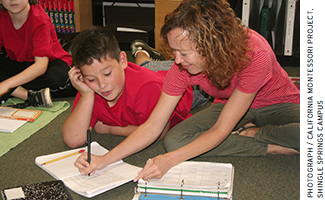
Kim Zawilski, principal of a Montessori charter in Shingle Springs, a tiny bedroom community well outside Sacramento, runs a K–8 school that serves 370 students and has a waitlist of nearly as many. Nearly all the students are white, with a small population of Native Americans. There are almost no students living in poverty. Most of the parents have college degrees and are working either in the state government or at technology firms. Zawilski seems puzzled when I ask about race/ethnicity and income. The school, she points out, reflects the community. It’s the kind of question only asked by someone from the East Coast.
Zawilski’s school is one of seven campuses in the Sacramento area run by the California Montessori Project. Other schools in the network have far higher numbers of low-income and minority students, points out executive director Gary Bowman. “The big thing is we want to provide a methodology that up until the charter movement only the affluent could afford. We strongly believe in the methodology and believe it will have a tremendous impact on the world. We know the world can’t be changed if you only serve the affluent.” In short, the project aims to bring Montessori to the broader population.
But it’s not just the specialty charter schools in California that draw middle-class parents. In Rocklin, an affluent suburb outside Sacramento, the Rocklin Academy Schools serve the same students—nearly all white or Asian, nearly all the children of college-educated parents—that are served in the well-regarded public schools. So why have a charter school?
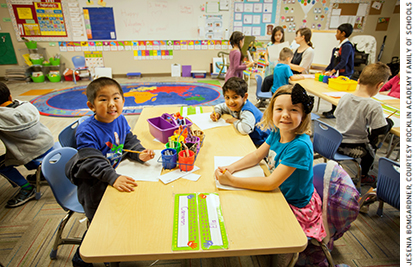
Big school districts become academically complacent, explains Rocklin charter founder David Patterson. “They become one-size-fits-all schools where sports are more important than academics. The football team got more attention than other things. There was even an anti-intellectual bias.”
Patterson and other parents wanted something different, so they designed their own school, one based on a Core Knowledge curriculum. And they found plenty of interest. The first school, offering grades 3–6, opened in 2001, and the academies kept expanding in grades and students. Today, four Rocklin charters serve 1,400 students from preschool through high school. The relationship with the local Rocklin district has been rocky, but the demand remains steady, with several hundred students on waitlists.
Patterson now works with an urban charter school in Sacramento. Asked about the difference between urban and suburban charter parents, Patterson replied, “In the inner city, parents first want a school that’s safe, where their children won’t get hurt or shot and hopefully will be around adults who care about them. Suburban parents already bought that and now have to think about what they want their children to experience, the academic engagement, and whether they want to be part of that as true partners.”
Said Wallace, “Suburban charter schools are a vital part of the success of California’s charter-school movement. Not only have some of our most successful charter-school organizations gotten started in suburban settings…parents and communities embracing charter schools in middle-class areas generate critically needed additional advocacy strength.”
Whether in urban or suburban charters, the rise in middle-class enrollment bears watching to see whether resistance grows or the California mind-set and the attendant political muscle spreads east.
But Are the Charter Schools Better?
There remains the question of quality. Are the charter schools pulling in middle-class parents any better than the schools those children left? At Blackstone Valley Prep, analysis of the suburban and urban students’ scores on the 2013 state exams measuring proficiency in reading and math offers 80 different snapshots, by grade, subject and family income, with Blackstone students faring better than their peers on nearly all. Said Chiappetta, “When children attend schools that are socioeconomically diverse, everyone benefits. As an educator and a parent, I think BVP’s results make an incredibly compelling case for truly diverse schools.”
In suburban San Antonio, the schools are too new to evaluate by academic achievement, and self-selection bias will make it hard to do so: schools that are designed to appeal to students and parents looking for faster-paced academics would be expected to appear at the top of state school rankings. In Arizona, a state that has always had charter schools that draw middle-class students, there is evidence that, on average at least, charters are not doing any better at raising student achievement than district schools; outside of urban areas, they appear to do a bit worse. Similar findings hold, on average, for suburban students in Massachusetts, although the charter schools they attend are nonetheless consistently oversubscribed. “The National Charter School Study 2013,” by the Center for Research on Education Outcomes (CREDO) at Stanford University, examined results in 26 states and concluded that charter schools offer the greatest academic promise for inner-city students. If one looks at the data for elementary and middle schools separately, however, it appears that in the higher grades, charters have a positive impact in reading on higher-income students relative to the district schools.
In California, there is evidence from CREDO that charters serving low-income students in Los Angeles are doing far better than the district schools, but available data do not allow true comparisons of middle-class charters to district schools. California is probably the best example of the difficulties of searching for reliable data on the question of academic gains for suburban charter students. Of course, parents don’t send their children to Montessori or Waldorf schools so they can outscore other students on state tests.
If the question of quality can’t be answered yet, then what’s the significance behind the growth in middle-class students attending charters? Probably the political clout those parents bring, whether it comes from those choosing free Montessori schools or those seeking more academic rigor. Letter-writing campaigns like the one in San Antonio are just the beginning.
“At least in San Antonio, the big difference between low-income and middle-class parents,” said Victoria Rico. “is that middle-class parents are louder and have better access to decision makers…When educated parents experience a BASIS or Great Hearts school, they realize what is possible in public education, and their voices are driving a whole new conversation about rigor, teacher quality, and advanced course options…They write op-eds. They visit with their elected representatives. They question the status quo in a way that is great for all kids.”
In short, might there be a benefit to underserved communities of having middle-class parents drive demand for charter schools?
Richard Whitmire is an Emerson Collective fellow and author of On the Rocketship: How Top Charter Schools Are Pushing the Envelope.
This article appeared in the Summer 2015 issue of Education Next. Suggested citation format:
Whitmire, R. (2015). More Middle-Class Families Choose Charters: A political game changer for public school choice. Education Next, 15(3), 32-39.


